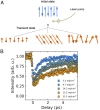Laser-induced transient magnons in Sr3Ir2O7 throughout the Brillouin zone
- PMID: 34039712
- PMCID: PMC8179144
- DOI: 10.1073/pnas.2103696118
Laser-induced transient magnons in Sr3Ir2O7 throughout the Brillouin zone
Abstract
Although ultrafast manipulation of magnetism holds great promise for new physical phenomena and applications, targeting specific states is held back by our limited understanding of how magnetic correlations evolve on ultrafast timescales. Using ultrafast resonant inelastic X-ray scattering we demonstrate that femtosecond laser pulses can excite transient magnons at large wavevectors in gapped antiferromagnets and that they persist for several picoseconds, which is opposite to what is observed in nearly gapless magnets. Our work suggests that materials with isotropic magnetic interactions are preferred to achieve rapid manipulation of magnetism.
Keywords: iridates; time-resolved resonant X-ray scattering; transient magnetic excitations.
Conflict of interest statement
The authors declare no competing interest.
Figures




References
-
- Averitt R. D., Taylor A. J., Ultrafast optical and far-infrared quasiparticle dynamics in correlated electron materials. J. Phys. Condens. Matter 14, R1357–R1390 (2002).
-
- Dean M. P. M., et al. , Ultrafast energy- and momentum-resolved dynamics of magnetic correlations in the photo-doped mott insulator . Nat. Mater. 15, 601–605 (2016). - PubMed
-
- Basov D. N., Averitt R. D., Hsieh D., Towards properties on demand in quantum materials. Nat. Mater. 16, 1077 (2017). - PubMed
-
- Gandolfi M., Celardo G. L., Borgonovi F., Ferrini G., Avella A., Banfi F., Giannetti C., Emergent ultrafast phenomena in correlated oxides and heterostructures. Phys. Scripta 92, 034004 (2017).
-
- Wang Y., et al. , Theoretical understanding of photon spectroscopies in correlated materials in and out of equilibrium. Nat. Rev. Mater. 3, 312–323 (2018).
LinkOut - more resources
Full Text Sources
Other Literature Sources
Research Materials

